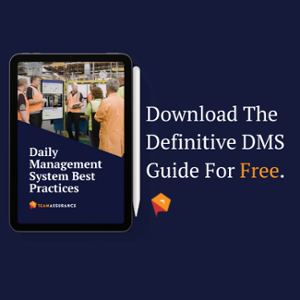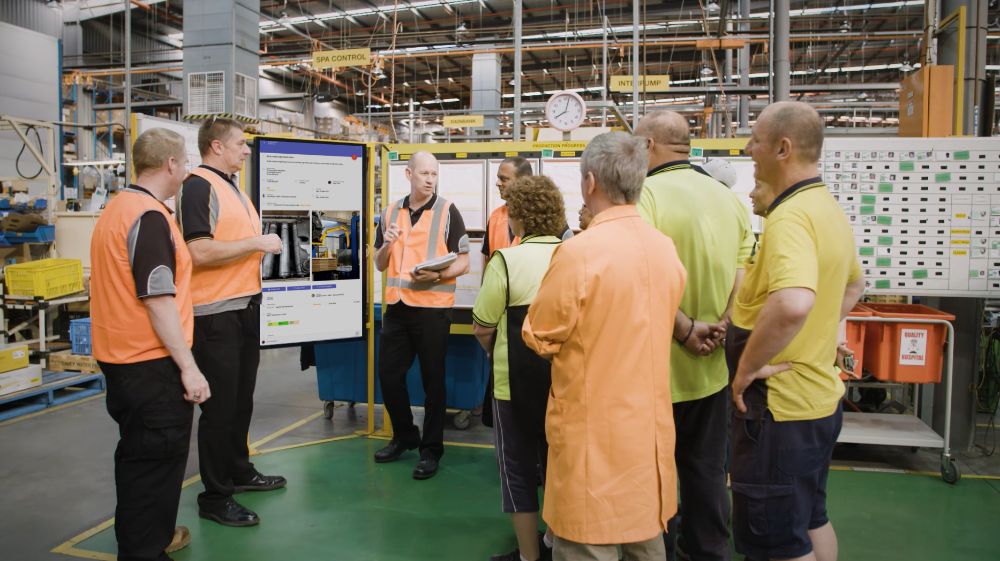Setting up a Lean Daily Management System

A Lean Daily Management System is critical for industries like manufacturing, healthcare, big box retail, warehousing, transport and logistics. Why? Traditional modes of top-down communication – email, meetings, intranet – are built for deskbound workers. They are not effective or practical for the 80 percent of the global workforce that don’t sit at a desk. Deskless workers don’t have a laptop, or the capacity to attend meetings throughout the day. The design and format of a Daily Management System allows information to be swiftly communicated across teams, through the site hierarchy and between sites.
Lean Daily Management System Explained
A Lean Daily Management System (DMS) facilitates the flow of critical information throughout the organization, both vertically and horizontally. How? By visualizing data and bringing team members together in a huddle to review, learn and discuss it together. They’re less ‘weather report’ and more about delivery, accountability, and developing a continuous improvement mindset. These huddles occur at each level of the organization, and information is shared between them. This creates a system of learning, communication, escalation and improvement.
How often should teams huddle?
If management are complaining about meeting overload, it’s likely the root cause is that frontline teams are not huddling. That means two-thirds of the workforce are not engaged beyond their workstation. And it’s the managers that are most impacted. They’re caught in the middle due to miscommunication both up and down the levels. Then when small problems blow out to a crisis, the finger of blame is pointed at the managers.
That’s why it’s important for the frontline to huddle each shift (Tier 1) or daily (Tier 2). Operations managers meet daily (Tier 3) and Executives huddle weekly or monthly (Tier 4). Whatever the cadence, these standups are the heartbeat of your organization. If one level of the tier is not huddling, you’ve got an irregular heartbeat. In addition, the frequency that teams huddle influences the flow of information up and down, and side to side. When each level is huddling consistently, the decisions will be made in a timely manner. This structure also prevents the otherwise inevitable and insidious sit-down progress meetings.

Agenda for a team huddle
The purpose of a huddle is not about reporting problems – that should be done prior. It’s more about awareness, sharing solutions and plans, and learning.
Make decisions
Teams can make most decisions at their level, since they have the most knowledge and context of the situation. However, don’t fixate on solving each and every problem. Decide next steps, agree actions and move on. Escalate if necessary, but make escalations the exception.
Leverage the team’s time
A huddle is the daily or weekly standup classroom – without people feeling like it is. Reinforce standards by recognizing good performance. Leaders should look for coaching moments, where one person’s actions can be a learning for the entire team. For example, a positive behaviour observation is where you catch someone doing the right thing. Sharing it can be the fastest way to raise the bar on safety for the whole team.
Review Metrics
Regular meetings commonly look at the Lag indicators. For example, injuries or overdue tasks. A huddle in a Daily Management System will also look at Lead indicators. For example, the percentage of quick risk assessments completed before a new task was started and the hazards mitigated.

When to start?
You might be reading this to understand when you will be ready to start a Daily Management System. The very real truth is – now. If you’re thinking “we’re not ready”, I can tell you that’s not true for two reasons. Firstly, each day you delay will increase the risk of missing a ‘clanger’. That’s a big hairy issue that’s lurking, thriving on the lack of teamwork and silence – ready to bite you on the backside. Secondly, the team will immediately use this meeting to improve it! The meeting agenda and format is the first thing the team can collaborate on to agree next steps.
How to start
Your people already have frustrations, problems and expertise swirling about in their heads. They need a psychologically safe forum to raise and discuss it. If they don’t feel safe enough to participate, they will disengage. Or worse, drive at a hundred-miles-an-hour in the wrong direction. So gather the team around the visual management and get started! As an example, a typical Shift start-up huddle only needs the following:
- 5 minutes set aside
- Someone (anyone) to run it
- A look back on the previous 24 hrs
- Run though a typical agenda such as Safety, then Quality, then Delivery
- What went well? Recognise this
- What went wrong? How can it be fixed? What follow up is needed? By who and by when?
- A look ahead at todays plan
- Possible risks, coordination needed, safety reminder
- A Visual Management Board may break the plan down into hourly targets
That’s enough to start a huddle. However, remember that this is a system. Anything discussed in a huddle needs to flow up and down, or across to other tiers. This interconnection creates the system. Which means there needs to be a way to share information to other tier meetings in real-time, with rich context. That includes text, photo, video, root-cause analysis and any related activity. This is where a digital system can significantly accelerate communication and boost productivity.
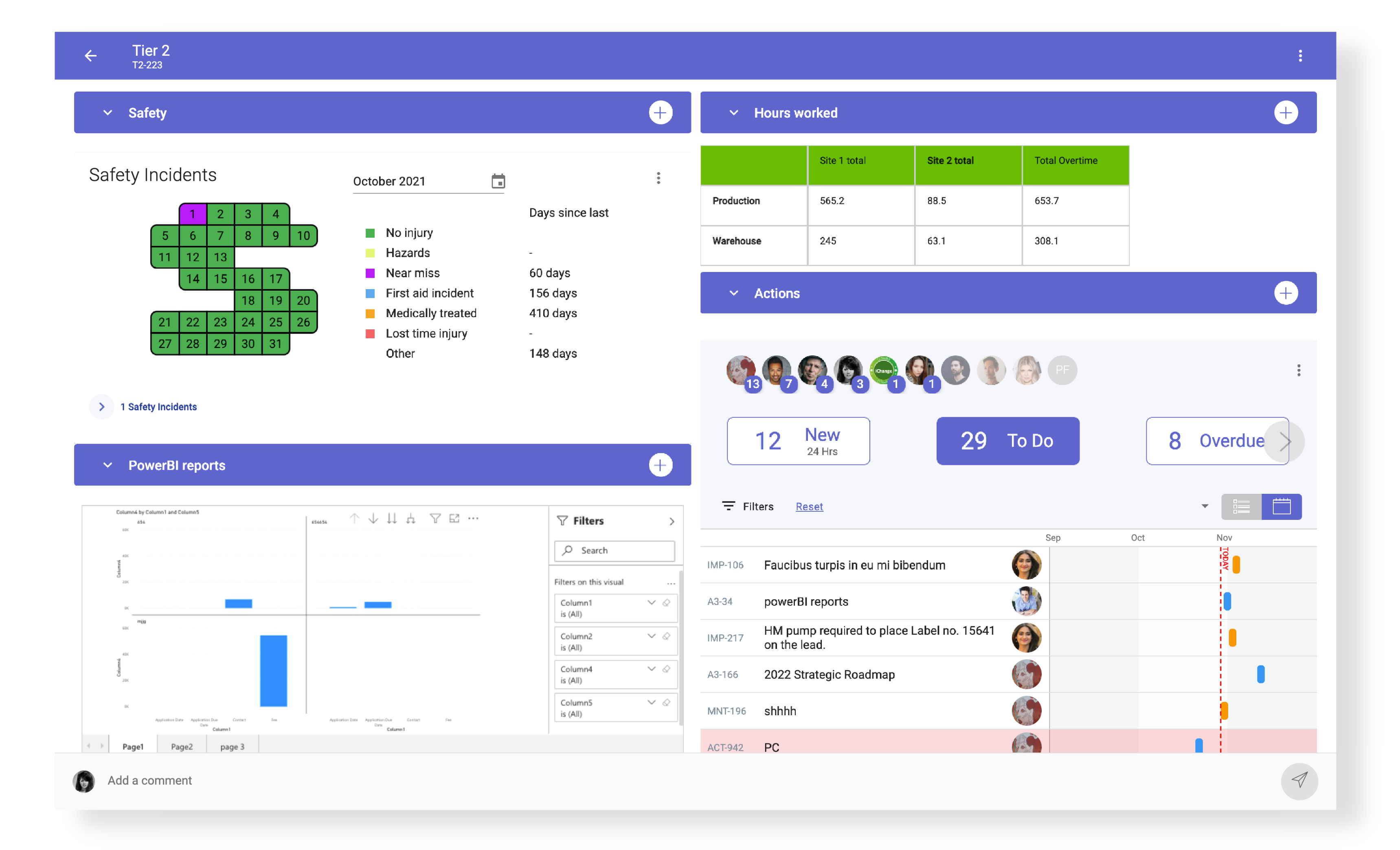 Learn more about visual communication options to maximise your tiered meetings.
Learn more about visual communication options to maximise your tiered meetings.
Digital tools
Whiteboards are great for a specific team to carry out the Plan-Do-Check of PDCA. However, whiteboards are detrimental to productivity if used for the “A” – Act. The organization owns the A. Whiteboard actions are only visible to people in that area, at that moment in time (before they are erased. Oops). Whiteboards can’t send reminders either. It might as well be written on toilet paper! Digital is the perfect medium for managing actions. Why? Assigning a task to someone with a due date requires visibility beyond the team. It often requires input from people outside the team. Tracking, follow-up and escalation in real-time is necessary for decisions. And building up a history, with data that can be searched weeks and months later, can save a lot of pain in the future.
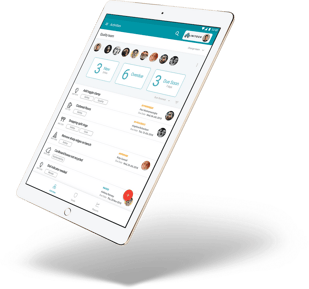
Digital solutions solve this. There are plenty of options for deskbound workers. Sharepoint and spreadsheets, or other more project management focussed tools. Many organizations try to get away with these. However, these tools fail to bridge the gap from the supervisor (or team leader) to the frontline. For the frontline, if a digital solution is nearly right, it might as well be a mile away. Find a cloud-based, responsive solution that is purpose built for a Daily Management System. It should work on tablets (for the frontline), kiosks (for huddles), laptops and phones (for management).
The Superpower of a Lean Daily Management System
When the tier meeting structure is being established, it is the perfect forum to improve huddles. In this way, it is self-sustaining and always improving. This is in contrast to waiting until the day the organization is ready. Which, incidentally, never comes. That’s because as each huddle matures, everyone’s capabilities and expectations rise. You should always have that healthy tension, and a nagging feeling that the team can always do better.
When you’re having a daily huddle, the team is incrementally improving more than 240 times a year. This improvement compounds over time. If you improve performance by 1% each huddle, you’ll be more than 10x better after a year (1.01^240=10.9). Here’s a few tips to improve the system each time;
- Anyone can lead the meeting
- Challenge poor performance and behaviour, not the person
- Emphasise bringing evidence of team discussion and problem solving to the meeting, not personal opinions
- Discuss improvement opportunities in the same way
- Share learnings between teams to accelerate improvement
- The communication between tiers is visible in each meeting
- You’re done in under 15 minutes
Benefits of a Lean Daily Management System
A Daily Management System provides a consistent and scalable way for the organization to improve and boost productivity. From top to bottom, left to right.
100% engagement. Everyone is in a team, therefore 100% of employees should participate in a huddle.
Strategic alignment. A clear connection to the overall strategy of the organization – the compelling organizational needs.
Improvement framework. Standardisation and strengthening of the ‘way we work here’. Without this, an organization never improves.
Information access and flow. The appropriate use of relevant data at each tier and function. Not too little, not too much – just enough.
Part of a C.I Framework, Not A Locally Optimised Island
In summary, a lean DMS system will bolster your daily management efforts; aligning people with their organisational and department goals every single day. It will facilitate focus, and stimulate meaningful conversations around sustainability and improvement. A quality DMS will also ensure information reaches the right people at the right time, providing the necessary support and resources for individuals (and teams) to thrive. Included elements like standardised problem solving techniques, documented Standard Operating Procedures (SOPs), and an embedded Tiered Daily Management process that supports the entire PDCA loop all play their part.
Therefore we must not think of any element of the DMS as a locally-optimised island.
The illustration below demonstrates how we designed TeamAssurance as an interconnected platform to avoid disconnected ‘Point Solutions’ (digital or analog) that do not help, or may even hinder the objectives of undertaking a Lean transformation.
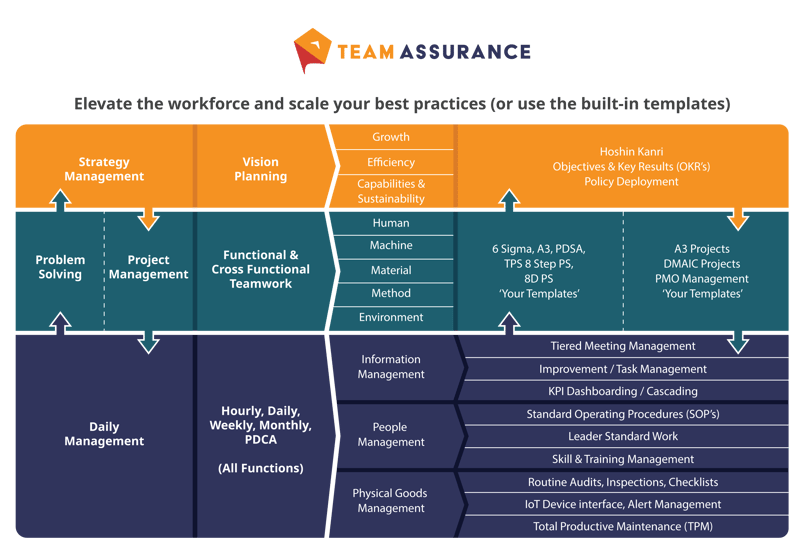
TeamAssurance is a Lean Daily Management System for organisations that want to boost productivity and develop problem-solving skills in their people. If you’re a business in need (or a consultant with clients in need) and you'd like to discuss the opportunities that digital-aids to Lean tools provide contact us for a demonstration of the TeamAssurance platform.
